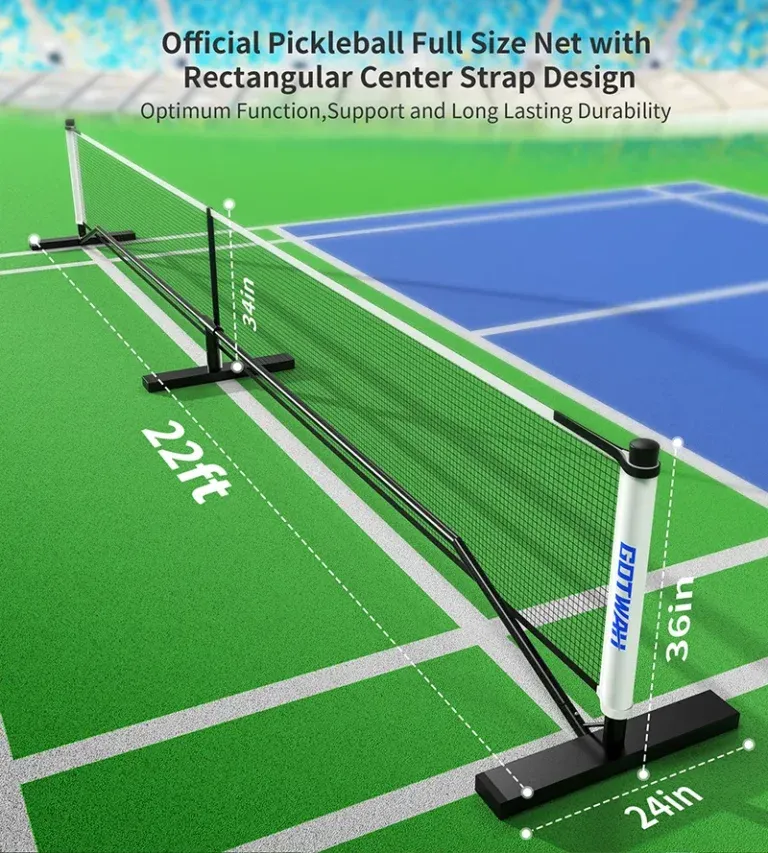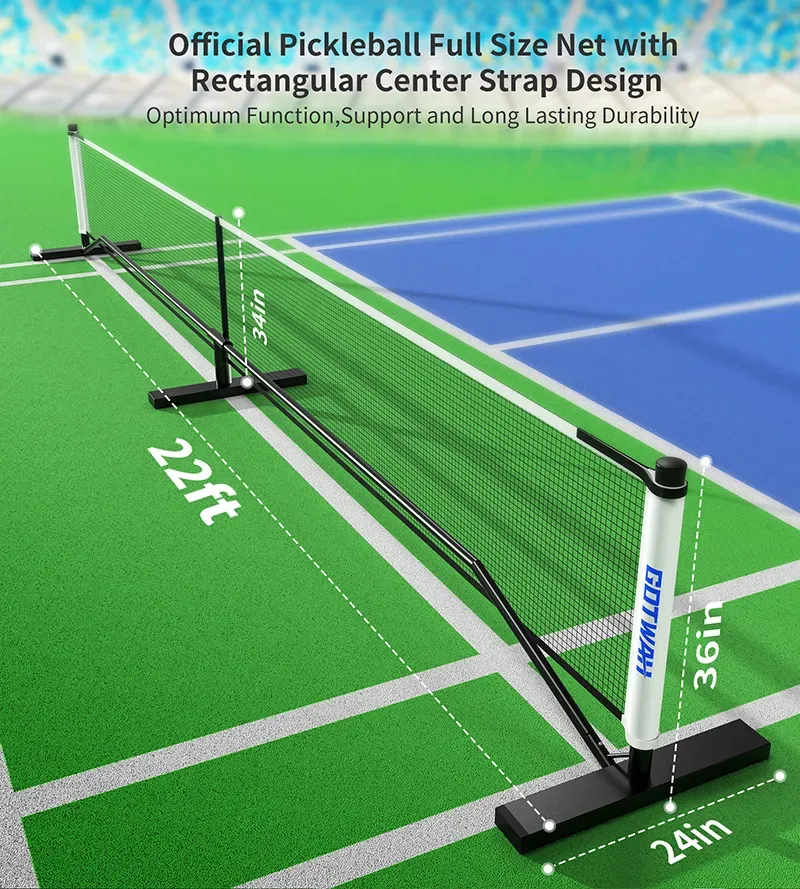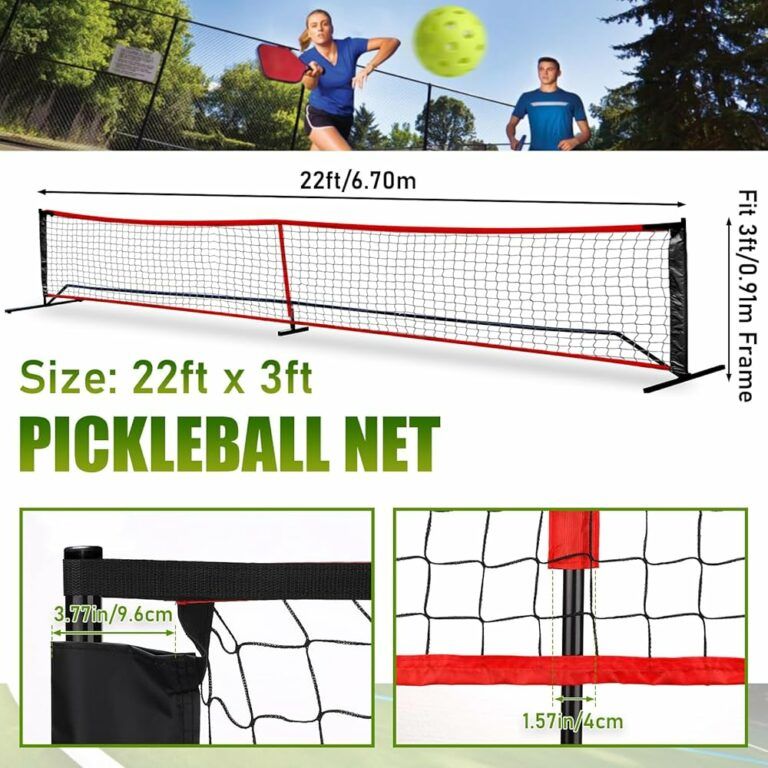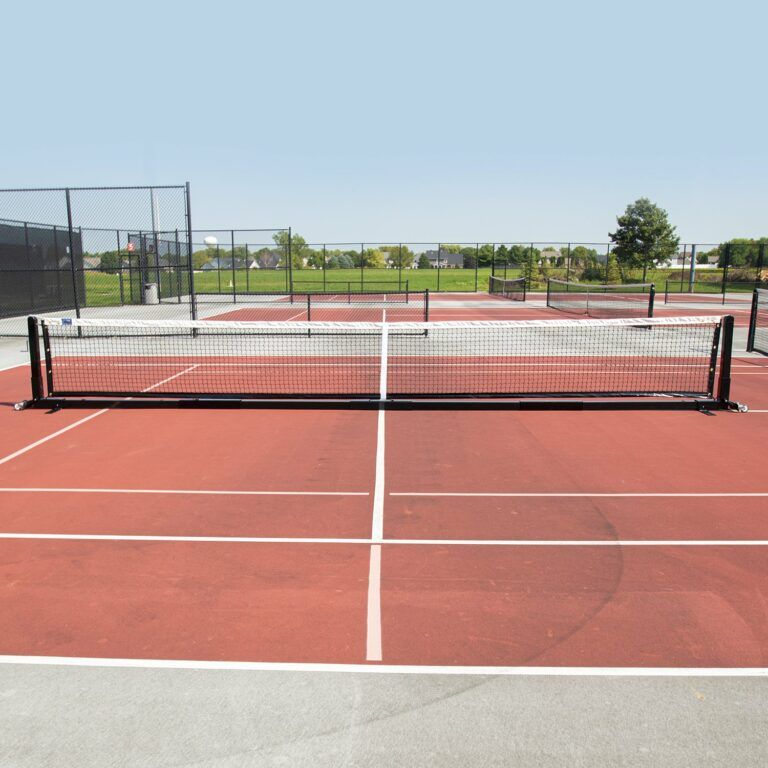Pickleball Net Height: Understanding the basics
To appreciate the nuances of pickleball net height, it’s essential to understand its fundamentals. The official specifications dictate that the net must be 36 inches (91.5 cm) high at the sidelines and 34 inches (86.4 cm) at the center of the court. This design creates a gentle arc, with the center being slightly lower than the edges, which encourages varied shot trajectories and angles. Whether you’re a seasoned pickleball player or a casual enthusiast, these dimensions are crucial in maintaining fairness and promoting an exhilarating game.
These height specifications are stipulated by key governing bodies, notably the USA Pickleball Association (USAPA) and the International Federation of Pickleball (IFP). These organizations not only ensure that the game is played under standardized conditions but also emphasize the importance of equipment specifications in fostering competitive integrity. As we delve deeper into this topic, we will examine why this height difference exists and how it contributes to the dynamic nature of pickleball.

Official pickleball net height and width
Regarding dimensions, the pickleball net is 22 feet wide, which accommodates the court’s overall design. The height difference between the sidelines and the center allows for a more engaging playing experience. Here’s a detailed look at the dimensions:
| Specification | Measurement |
|---|---|
| Height at Sidelines | 36 inches (91.5 cm) |
| Height at Center | 34 inches (86.4 cm) |
| Width | 22 feet (6.71 meters) |
This intentional design not only respects physical aspects of the game but also injects a dose of strategy, as players must adapt their shots according to the net’s height, influencing the pace and types of shots used throughout the match.
Why is the pickleball net lower than a tennis net?
The pickleball net height is notably lower than that of a traditional tennis net, which stands at 42 inches (106.68 cm) at the sidelines and 36 inches (91.44 cm) in the center. But why is this the case?
The rationale behind the lower net height primarily revolves around the characteristics of the balls used in each sport. Pickleballs are lighter than tennis balls, and they possess distinct bounce dynamics. A tennis ball, heavier and more resilient, tends to bounce higher off the ground, necessitating a taller net to challenge players. Conversely, pickleballs, designed for fluid play, have less bounce, which allows players to execute shots more creatively and strategically under a lower barrier.
This design choice resonates with the game’s ethos, encouraging dynamic rallies and stimulating exchanges, and enabling players to explore their shot-making abilities while adding an exciting rhythm to the game. As players master the art of placement and timing, the lower net height plays a pivotal role, enabling a variety of techniques that would otherwise be unfeasible under more restrictive conditions.

Pickleball nets vs. tennis nets
Understanding the differences between pickleball and tennis nets is crucial for appreciating how net height can influence gameplay. While both sports rely on nets as barriers that define their playing fields, the specifics of these nets vary significantly, which can necessitate player adaptations and modifications.
Side-by-side comparison of net dimensions
Here is a clear breakdown of the critical differences between pickleball and tennis nets:
| Feature | Pickleball | Tennis |
|---|---|---|
| Height at Sidelines | 36 inches (91.5 cm) | 42 inches (106.68 cm) |
| Height at Center | 34 inches (86.4 cm) | 36 inches (91.44 cm) |
| Width | 22 feet (6.71 m) | 42 feet (12.8 m) |
As evident from the table, the tennis net not only stands taller but is also significantly wider. This height difference can have a substantial impact on gameplay.
How net height affects gameplay in each sport
In pickleball, the lower height promotes a faster and more agile pace, allowing players to hit a variety of shots, including powerful smashes and delicate dinks. The strategic placement of shots becomes a critical component of gameplay, as players must utilize angles and trajectories that are more forgiving due to the net’s design. When engaging in pickleball, players find themselves employing diverse tactics such as positioning themselves closer to the net and relying on quick reflexes to place returns effectively.
Conversely, the taller tennis net challenges players to harness greater power and precision with every shot, forcing a more aggressive play style that often requires advanced skills in ball placement and depth control. This difference reflects the unique nature of each sport, where the net serves as a distinctive factor that influences how the game is played and how players undertake their strategy.
Adapting a tennis net for pickleball
Using a tennis net for pickleball may seem like a quick fix for those looking to play without the proper equipment. However, it’s crucial to understand that adapting a tennis net to meet pickleball standards requires careful consideration and adjustment.
Can you use a tennis net for pickleball?
Yes, a tennis net can technically be used for pickleball games, but it’s not ideal. The higher net does not align with the intended gameplay style of pickleball and may compromise the fairness and enjoyment of the match. Players may find themselves adjusting shot trajectories unnecessarily or even struggling to connect their shots effectively due to the differing net height.
Methods for lowering a tennis net
If a player decides to use a tennis net for pickleball, there are methods to adjust the net’s height. Some options include:
- Center strap: Adjusting the strap at the center may help lower the tension and reduce the height slightly.
- Converter straps: Utilizing additional straps or converters can aid in lowering the overall height.
- External adjusters: Some players creatively use weights or other tools to help lower the net during the game temporarily.
It’s important to remember that while these methods can make a tennis net more suitable for pickleball, they can’t replicate the precise measurements mandated by regulations.
How using a tennis net affects pickleball play
When using a tennis net, players may notice steep learning curves in shot trajectories due to the increased height. The expected mix of personal creativity and technical skill found in pickleball gameplay can become stifled, potentially leading to frustration and hindered performance.
The taller net demands players to adjust their shots in a way that may not feel natural, distancing them from the play style inherent to pickleball. Learning to engage effectively with the net’s height is essential for proper gameplay and maintaining the game’s integrity.
Best practices for optimal pickleball play
For the best possible experience and to avoid misunderstandings during gameplay, always opt for portable pickleball nets or seek dedicated pickleball courts. Purchasing a regulation net means ensuring all players have a consistent and fair court experience where they can thrive and focus on honing their skills.
Pickleball net construction and features
The way a pickleball net is constructed significantly impacts its performance, durability, and convenience. Understanding the materials and design features can guide players and organizers in selecting the right net for their games.

Common pickleball net materials
Pickleball nets are typically made from durable materials like:
- Nylon: Known for its strength and flexibility, nylon nets can endure outdoor conditions while maintaining their form.
- Polyethylene: This material is lightweight and resistant to wear, making it suitable for commercial venues.
- Polyester: While it may not be as resilient as nylon, polyester offers affordable options for casual players.
Choosing the right material leads to maintaining net integrity and consistent performance across gameplay.
Types of pickleball net frames
When purchasing a pickleball net, one also needs to consider the frame, with two prevalent types:
- Steel frames: These provide superior stability but can be heavier and less portable. Ideal for permanent installations.
- PVC frames: Lightweight and easy to transport, PVC frames are perfect for portable nets, allowing for quick setups and takedowns.
Both choices come with trade-offs, so understanding your playing circumstances is vital when deciding.
Weight considerations for pickleball nets
Weight can significantly influence how players transport and set up nets. Typical weights range from 10 to 30 pounds (4.5 to 13.6 kg), largely dependent on frame material and design. Lightweight frames enhance portability but may compromise stability, whereas heavier options provide lasting performance during competitive play. Consider also the carrying bags available, as they are essential for ease of movement.
Setting up your pickleball net
Properly setting up a pickleball net is crucial for a successful game, ensuring that the height and alignment adhere to official specifications. There are two types of setups mainly Permanent vs. portable pickleball nets
Permanent vs. portable pickleball nets
Permanent nets are typically installed on designated courts and are designed for long-term use, while portable nets are favored for recreational play or those looking to set up temporary courts in diverse locations. Each type has its unique advantages. Portable nets offer flexibility and convenience, while permanent nets guarantee stability for frequent competitive use.

Step-by-step guide to setting up a portable net
Getting a portable pickleball net ready requires careful attention. Here’s a simple step-by-step guide:
- Position the posts: Set the posts at the designated distance of 22 feet apart.
- Secure the base: Ensure that the net stands firm with properly secured bases.
- Adjust net tension: Pull the net tightly to avoid sagging, checking that it maintains the appropriate height at both sidelines and center.
- Verify height setting: Finally, measure to confirm that the net stands at the required heights of 36 inches (91.5 cm) at the sides and 34 inches (86.4 cm) at the center.
Setting up permanent pickleball nets
For permanent nets, considerations include court surface type, post installation techniques, and appropriate anchoring mechanisms to ensure that the net remains stable and in compliance with the regulations. Additionally, confirm the net’s durability against environmental elements, particularly if set up outdoors.
Pickleball net care and maintenance
Proper maintenance can extend the life of a pickleball net, ensuring it performs well during games and remains in peak condition.
Why pickleball net maintenance matters
Regular maintenance not only enhances the longevity of your net but also guarantees optimal playing conditions. A well-maintained net maintains its height and tension, creating a level playing field for all participants.
Cleaning and storing your pickleball net
To keep your net in excellent shape, follow these guidelines:
- Cleaning methods: Use mild detergents mixed with water and a soft cloth to wipe down the net surfaces, avoiding harsh chemicals or scrubbing that may harm the material.
- Storage techniques: When not in use, store the net in a dry, cool place, away from direct sunlight to prevent wear and damage.
Inspecting and repairing your net
Regular inspections for signs of wear and tear can prevent substantial damage. Basic repair techniques include replacing frayed sections of the net or reinforcing weak spots with additional straps or patches. This proactive approach will ensure that the net remains functional and safe for all players.
Pickleball net height variations
The question of whether net height can change based on player levels or casual play settings can create discussions among enthusiasts.
Regulation net height for different player levels
As of the current standards established by the USAPA and IFP, there are no official variations for skill levels or age groups in terms of net height. The regulations remain constant to ensure fairness across all competitions.
Informal adjustments for casual games
In informal settings, players may opt to adjust net heights for recreational purposes. Whether lowering the net to cater to younger players or raising it for a more challenging experience, these informal changes can create engaging and enjoyable matches among friends and family.
How net height variations change the game
When net height is altered informally, players might find themselves facing different challenges and opportunities. Changes can influence shot dynamics and strategic elements of the game, making each match a unique experience. This adaptability showcases the spirit of pickleball, where creativity and innovation thrive amidst structured play.
The story behind pickleball net height
The evolution of the pickleball net height is a fascinating narrative that spans back to the inception of the game itself.
The origin of pickleball net height
Initially, pickleball was created using a badminton net as its primary barrier. Historical anecdote suggests that the improvised design was a product of Joel Pritchard’s waist height, leading to the decision on the net’s dimensions being somewhat slapdash yet effective. The informal beginnings of the sport reflect the improvised creativity that is a hallmark of its identity.
From experimentation to official rules
As the popularity of pickleball grew, the need for standardization became apparent, leading to the establishment of specific rules by organizations such as the USAPA. This evolution from an informal, backyard game to a structured sport significantly shaped how we understand the gameplay today, with net height playing a central role in artistry and competition.
Advanced pickleball net strategies
As players refine their games, advanced strategies can give them an edge in competitive settings. Understanding net height can be a game-changer.
Using net height to your advantage
The lower net height presents opportunities for advanced techniques, such as dinks and drops. Players adept at utilizing net height effectively can exploit their opponents’ movements, creating openings for winning shots.
Mastering net play and positioning
Positioning close to the net allows players to dominate the game with increased control. Techniques such as the “erne” an advanced shot executed near the net enable players to surprise their opponents and secure critical points. Understanding and mastering these techniques is essential for elevating one’s game to the next level.
FAQs
As pickleball continues to gain traction, players often have questions about nets and their specifications.
Can you use a badminton net for pickleball?
While a badminton net could technically be used for casual play, it fails to meet the required heights for pickleball and significantly diminishes the gameplay experience.
What happens if you play with the wrong net height?
If the net height deviates from the standardized measurements, it can create disparities in gameplay, resulting in frustration and uneven competition, impacting players' overall enjoyment of the sport.
Where can I buy a regulation pickleball net?
Regulation pickleball nets are widely available through sports retailers, specialized pickleball websites, and online marketplaces, making it easy for players to find the right equipment to enhance their gameplay.
Conclusion
Navigating the intricate world of pickleball net height unveils crucial aspects that significantly impact the game. From understanding the essential specifications and construction materials to exploring gameplay tactics and strategies, a comprehensive grasp of net height enhances a player’s overall experience. Embracing these details allows players to engage more deeply with the sport preparing for competitive play or enjoying casual matches with friends. In the end, the nets symbolize both a barrier and a bridge, allowing players to showcase their skills while fostering camaraderie and competition in the delightful game of pickleball.








